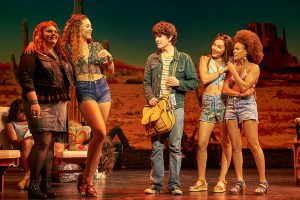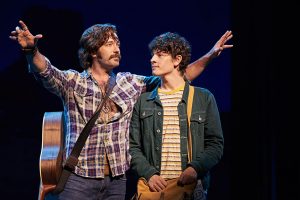Cameron Crowe Was Almost Famous in the Movies and Now On Old Globe Stage
I agree with Lester Bangs. It was all over in 1973 when Cameron Crowe was hanging out at the loading dock of the International Sports Arena, trying to meet rock ‘n’ roll stars.
New bands still were being born and crowds still packed the patrolled parking lots across the street next to Tower Records. But the musical dream had coarsened from the magical mid-60s into a race to see who could soonest get the higher and the richer. And Bangs, one of the earliest pop critics with a rep, was in burn-out when he met the yearning young Crowe.
The story of what happened next was told in Crowe’s bright, energetic 2000 film “Almost Famous,” which now is being fluffed into a musical comedy at the Old Globe Theatre, with Crowe an emphatic participant. The piece, thus far in its development, is fun. But for those of us who were there, it’s a glib skate down the peaks, using inherited momentum.
In 1973, the concept of “pop critic” was still scarcely a decade old. Magazines and newspaper had always tracked and printed the gossip about radio and juke-box stars but the idea of taking the songs seriously, beyond June-moon-croon to actual art, was a product of the 1960s, churned up in the wake of movie and jazz critics and fed by a sudden flair of genius creators and performers such as Bob Dylan and the Beatles. Abruptly, for audiences stimulated by senseless war, new fashions in drugs and a growing tingle of liberation, the music seemed to make sense of everything. And clever writers could help make sure it did.
As the mass market erupted and the money flooded in, the art became harder to find. There was a demand for lively writers, starting with community papers like the Los Angeles Free Press and the Berkeley Barb, moving soon into mass media and specialty national publications like Rolling Stone and CREEM. By 1973, pop music was big business indeed, art or no art. And people from the first wave, like Lester Bangs, were suffering from lost control.
Young Cameron Crowe had abundant talent, as his subsequent career has confirmed, but he was an innocent babe, scarcely 15 and protected by a dominant mom wielding a curfew. Hanging around the fringes of the San Diego music scene, he met Bangs, who saw some of his stuff and helped steer him into the pandemonium of big-time pop music.
Almost Famous casts Bangs as spirit guide/mentor as he fills the kid with veteran insight, mostly variations on the basic theme of writing valid criticism – It’s the song, not the singer. – and the tactical input that makes the job work: How to get access.
Bangs, who was fired from Rolling Stone for “disrespecting musicians” and who himself edited CREEM for a few years, knew whereof he spoke. He suggested a start by trying to crash the stage door and if that didn’t work, try hanging out with the groupies. And that’s where the Globe show (and the movie) really begins to roll.
Armed with an assignment from Rolling Stone and abundance of fresh-faced charm, Crowe (“William Miller”) imbeds himself into a tour by a (fictional) group called Stillwater and proceeds to lose his innocence but get the story.
Names are changed, maybe for legal considerations. Songs are borrowed from all over – David Bowie, Joni Mitchell, Jimmy Page and Robert Plant, Elton John, Greg Allman, Cat Stevens – with Crowe and Tom Kitt filling the gaps.
Nineteen actors play about three times that many roles and Derek McLane’s sets gallop through endless locations, some of them very nice (a city skyline) but many just functional. It’s all a blur, which actually makes sense for this story. The same can be said for David Zinn’s costumes, restrained given the excesses of the era but accurate except for the over-use of labeled T-shirts. Natasha Katz’s lighting, too, opts for clarity over spectacle.
In the lead, Casey Likes is the kind of clean-cut, earnest kid anybody would choose to play themselves as a youth. Colin Donnell is the lead guitarist and Drew Gehling is the singer for Stillwater and all is well in both cases. Rob Colletti plays Lester Bangs as more of a slob than necessary, perhaps, but who really knows.

Left to right, Katie Ladner, Solea Pfeiffer, Casey Likes, Julia Cassandra and Storm Lever in Almost Famous at The Old Globe. Neal Preston Photo
The “Band-Aids” is the name assumed by (or assigned to) the four young women who, um, service the band and they’re a perky crew in circumstances viewed with a much different attitude these days. Long-legged Solea Pfeiffer plays the irritatingly named “Penny Lane,” acknowledged captain of the band, with such a gentle and dreamy air that she makes everything all right.
Anika Larsen finds a neat mix of responsibility and understanding that would charm any mom and the guys of the ensemble do a credible job of suggesting the fringe folks in this fantasy world.
Lorin Latarro’s choreography is standard stuff, beveled seamlessly into Jeremy Herrin’s overall efficiency of staging this panorama within the gauzy delights of Crowe’s memory. Is there also room for theatrical nuance? Not much. It’s really not that kind of show.
A couple of times, Crowe’s script uses cheap shots, like “I can’t carry a telephone with me!” Or, “Nobody expects Mick Jagger to still be doing all that 20 years from now.” That’s fine, though, because this isn’t some butt-kicking sermon. What Crowe does best is edgy fantasy. “Fast Times at Ridgemont High,” adapted from a piece he wrote for Rolling Stone after posing undercover as a student at Clairemont High School, fulfills a familiar grown-ups’ dream. And the under-rated “Jerry Maguire,” a knowing take on professional entertainment, is a wise fantasy.
He earned the right to do autobiographical musings by the success of those two films and others. The Almost Famous picture was an obvious labor of love and one that spoke to a wide and welcoming audience. The stage version just shows that he still enjoys poking at this fabled piece of his past.
But Crowe moved on from rock ‘n’ roll, remember. And I only say that, back then, he really was riding the caboose of that first great train. The art continues to surge over and over with new variations and new talent while the beloved old stuff remains appreciated in imitations and revivals.
Just don’t take this as some kind of peak point. Except in Cameron Crowe’s fertile memory.
(Continues on the Old Globe Theatre MainStage at 7 p.m. Tuesdays, Wednesdays and Sundays; at 8 p.m. Thursdays-Saturdays; and at 2 p.m. Saturdays and Sundays through Oct. 27, 2019.)



